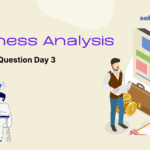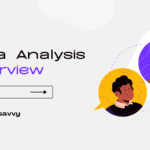Mastering Your Business Analyst Interview – Day 3
Introduction:
Welcome to Day 3 of our Business Analyst interview preparation series! Today, we’re diving deeper into technical questions and practical case studies to further sharpen your skills and boost your confidence for your upcoming interviews. Let’s explore 12 technical questions and 2 real-world case studies to help you ace your BI Analyst interview.
Technical Questions:
What is the difference between a SQL query and a stored procedure?
Answer: A SQL query is a single statement used to retrieve or manipulate data from a database, while a stored procedure is a precompiled set of SQL statements stored in the database and executed as a single unit.
How do you optimize SQL queries for performance?
Answer: SQL query optimization techniques include indexing, avoiding unnecessary joins, limiting the number of returned rows, and using proper data types. Additionally, analyzing query execution plans and profiling can help identify bottlenecks.
Can you explain the concept of data normalization and its importance in database design?
Answer: Data normalization is the process of organizing data into tables to reduce redundancy and improve data integrity. It ensures that each piece of data is stored only once and eliminates anomalies such as update, insert, and delete anomalies.
What is the purpose of an index in a database, and how does it improve query performance?
Answer: An index is a data structure that improves the speed of data retrieval operations on a database table at the cost of additional storage space and decreased insert/update performance. It allows the database engine to quickly locate rows based on the indexed columns.
How do you handle data transformation and cleansing in ETL processes?
Answer: Data transformation involves converting raw data into a consistent format suitable for analysis, while data cleansing involves identifying and correcting errors or inconsistencies in the data. Techniques include data validation, standardization, deduplication, and outlier detection.
What is the role of metadata in a BI environment?
Answer: Metadata provides information about the structure, content, and context of data stored in a BI system. It helps users understand and interpret the data, facilitates data governance, and supports data lineage and data quality management.
Can you explain the concept of OLAP and its advantages over OLTP?
Answer: OLAP (Online Analytical Processing) is designed for complex analysis of large volumes of historical data to support decision-making. It allows users to perform multidimensional analysis, drill-down, and slice-and-dice operations for in-depth insights. OLAP systems are optimized for read-heavy workloads and analytical queries, whereas OLTP (Online Transaction Processing) systems are optimized for write-heavy transactional workloads.
How do you handle concurrency and locking in database transactions?
Answer: Concurrency control mechanisms such as locking ensure that database transactions are executed in a consistent and isolated manner to prevent data corruption or inconsistency. Techniques include row-level locking, table-level locking, and optimistic concurrency control.
What is data warehousing, and how does it differ from a traditional relational database?
Answer: A data warehouse is a centralized repository that stores structured and historical data from multiple sources for analysis and reporting purposes. It differs from a traditional relational database in terms of its focus on analytical queries, data consolidation, and support for complex data models such as star schemas and snowflake schemas.
How do you ensure data security and privacy in a BI environment?
Answer: Data security measures include role-based access control, encryption, data masking, auditing, and compliance with regulatory requirements such as GDPR and HIPAA. It’s essential to implement security best practices at every stage of the BI lifecycle, from data collection to dissemination.
Case Studies:
Case Study 1: Retail Sales Analysis
Scenario: A retail company wants to analyze its sales data to identify trends, forecast demand, and optimize inventory management.
Task: Analyze historical sales data, create interactive dashboards and reports, identify top-selling products and regions, and provide recommendations for improving sales performance and inventory management.
Case Study 2: Customer Segmentation Analysis
Scenario: A marketing team wants to segment customers based on demographic information, purchasing behaviour, and engagement with marketing campaigns.
Task: Collect and analyze customer data from various sources, perform segmentation analysis using clustering algorithms, visualize customer segments, and recommend targeted marketing strategies to improve customer engagement and retention.
Conclusion:
Congratulations on completing Day 3 of our Business Analyst interview preparation series! By mastering these technical questions and case studies, you’re well-prepared to demonstrate your analytical skills, problem-solving abilities, and knowledge of BI concepts in your interviews. Stay tuned for more insights and tips as you continue your journey to becoming a successful Business Analyst










